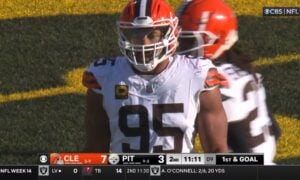It wasn’t so long ago that T.J. Watt had his skeptics. I was certainly among them. Even following his encouraging rookie season, many questioned whether the Pittsburgh Steelers outside linebacker would be able to elevate his game as a pass-rusher, or if he would always be more of a ‘complete’ edge defender rather than a high-end edge rusher.
Since about the middle of his second season, however, the former first-round pick has really blossomed into one of the top all-around defenders in the league, and a top pass-rusher as well. He has recorded 27.5 sacks over the past two seasons, and forced 14 fumbles, the majority of them coming at the end of sacks.
Part of that has been because of his accumulation of on-field experience, but he has also taken big steps in his game because of his growth in the classroom as well, something he had talked about a number of times. He even credits observing Minkah Fitzpatrick for making him pick up his note-taking game.
While appearing recently on the Marty Smith Podcast, Watt was asked about what he feels he’s improved upon the most since he entered the league, and he talked specifically about these two things: studying film and rushing the passer.
I would just have to say my film study, my pass rush. I think those are the two areas that I’ve really been able to blossom in, and I want to just continue to get better at. You watch a lot of film in college, and in the first few years in the NFL, and you don’t really realize how much you can pick up, not only on game film but on TV copies and listening and just, all the things that are ‘tells’ that a lot of guys just kind of look past in the film room.
While he has picked up his sack numbers, Watt has also become a consistent pass-rush threat, a regular presence in the backfield. In the past year and a half, his win rate, his pressure rate, and the number of hits he’s gotten on the quarterback have been much improved in comparison to the first year and a half of his career.
We have also seen him prove in the other phases of the game as well, and that can be credited not just to in-game experience, but, again, to film-room experience, not just exposure to more ideas, but cultivating the knowledge of how to break down what he’s seeing, and how to apply that in reality.
There probably aren’t a lot of elite players throughout NFL history who weren’t also tape-hounds. Even guys who may not come off as though they bother watching a lot of film, you may be surprised to learn were true students of the game. There is no greater advantage of being able to tell what your opponent is going to do before they do it.








